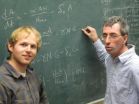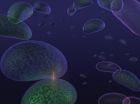(Press-News.org) Most people attempt to reduce the little uncertainties of life by carrying umbrellas on cloudy days, purchasing automobile insurance or hiring inspectors to evaluate homes they might consider purchasing. For scientists, reducing uncertainty is a no less important goal, though in the weird realm of quantum physics, the term has a more specific meaning.
For scientists working in quantum physics, the Heisenberg Uncertainty Principle says that measurements of properties such as the momentum of an object and its exact position cannot be simultaneously specified with arbitrary accuracy. As a result, there must be some uncertainty in either the exact position of the object, or its exact momentum. The amount of uncertainty can be determined, and is often represented graphically by a circle showing the area within which the measurement actually lies.
Over the past few decades, scientists have learned to cheat a bit on the Uncertainty Principle through a process called "squeezing," which has the effect of changing how the uncertainty is shown graphically. Changing the circle to an ellipse and ultimately to almost a line allows one component of the complementary measurements – the momentum or the position, in the case of an object – to be specified more precisely than would otherwise be possible. The actual area of uncertainty remains unchanged, but is represented by a different shape that serves to improve accuracy in measuring one property.
This squeezing has been done in measuring properties of photons and atoms, and can be important to certain high-precision measurements needed by atomic clocks and the magnetometers used to create magnetic resonance imaging views of structures deep inside the body. For the military, squeezing more accuracy could improve the detection of enemy submarines attempting to hide underwater or improve the accuracy of atom-based inertial guidance instruments.
Now physicists at the Georgia Institute of Technology have added another measurement to the list of those that can be squeezed. In a paper appearing online February 26 in the journal Nature Physics, they report squeezing a property called the nematic tensor, which is used to describe the rubidium atoms in Bose-Einstein condensates, a unique form of matter in which all atoms have the same quantum state. The research was sponsored by the National Science Foundation (NSF).
"What is new about our work is that we have probably achieved the highest level of atom squeezing reported so far, and the more squeezing you get, the better," said Michael Chapman, a professor in Georgia Tech's School of Physics. "We are also squeezing something other than what people have squeezed before."
Scientists have been squeezing the spin states of atoms for 15 years, but only for atoms that have just two relevant quantum states – known as spin ½ systems. In collections of those atoms, the spin states of the individual atoms can be added together to get a collective angular momentum that describes the entire system of atoms.
In the Bose-Einstein condensate atoms being studied by Chapman's group, the atoms have three quantum states, and their collective spin totals zero – not very helpful for describing systems. So Chapman and graduate students Chris Hamley, Corey Gerving, Thai Hoang and Eva Bookjans learned to squeeze a more complex measure that describes their system of spin 1 atoms: nematic tensor, also known as quadrupole.
Nematicity is a measure of alignment that is important in describing liquid crystals, exotic magnetic materials and some high temperature superconductors.
"We don't have a spin vector pointing in a particular direction, but there is still some residual information in where this collection of atoms is pointing," Chapman explained. "That next higher-order description is the quadrupole, or nematic tensor. Squeezing this actually works quite well, and we get a large degree of improvement, so we think it is relatively promising."
Experimentally, the squeezing is created by entangling some of the atoms, which takes away their independence. Chapman's group accomplishes this by colliding atoms in their ensemble of some 40,000 rubidium atoms.
"After they collide, the state of one atom is connected to that of the other atom, so they have been entangled in that way," he said. "This entanglement creates the squeezing."
Reducing uncertainty in measuring atoms could have important implications for precise magnetic measurements. The next step will be to determine experimentally if the technique can improve the measurement of magnetic field, which could have important applications.
"In principle, this should be a straightforward experiment, but it turns out that the biggest challenge is that magnetic fields in the laboratory fluctuate due to environmental factors such as the effects of devices such as computer monitors," Chapman said. "If we had a noiseless laboratory, we could measure the magnetic field both with and without squeezed states to demonstrate the enhanced precision. But in our current lab environment, our measurements would be affected by outside noise, not the limitations of the atomic sensors we are using."
The new squeezed property could also have application to quantum information systems, which can store information in the spin of atoms and their nematic tensor.
"There are a lot of things you can do with quantum entanglement, and improving the accuracy of measurements is one of them," Chapman added. "We still have to obey Heisenberg's Uncertainty Principle, but we do have the ability to manipulate it."
INFORMATION:
END
SALT LAKE CITY, Feb. 27, 2012 – University of Utah mathematicians developed a set of calculus equations to make it easier for doctors to save Tylenol overdose patients by quickly estimating how much painkiller they took, when they consumed it and whether they will require a liver transplant to survive.
"It's an opportunity to use mathematical methods to improve medical practice and save lives," says Fred Adler, a professor of mathematics and biology and coauthor of a study that developed and tested the new method.
The study of acetaminophen – the generic pain and ...
For the past decade, scientists have been pursuing cancer treatments based on RNA interference — a phenomenon that offers a way to shut off malfunctioning genes with short snippets of RNA. However, one huge challenge remains: finding a way to efficiently deliver the RNA.
Most of the time, short interfering RNA (siRNA) — the type used for RNA interference — is quickly broken down inside the body by enzymes that defend against infection by RNA viruses.
"It's been a real struggle to try to design a delivery system that allows us to administer siRNA, especially if you ...
PASADENA, Calif.—Bacteria have evolved different systems for secreting proteins into the fluid around them or into other cells. Some, for example, have syringe-like exterior structures that can pierce other cells and inject proteins. Another system, called a type VI secretion system, is found in about a quarter of all bacteria with two membranes. Despite being common, researchers have not understood how it works. Now a team, co-led by researchers at the California Institute of Technology (Caltech), has figured out the structure of the type VI secretion system apparatus ...
ZyLAB, a leading provider of eDiscovery and information management solutions, today announced that it has been named to KMWorld Magazine's prestigious list of the "100 Companies that Matter in Knowledge Management." Published annually and in its 12th year, this list recognizes organizations that play a role in the creation and evolution of the knowledge management market through consistent innovation of technologies, products and services. Companies chosen for this list are compiled by KM practitioners, theorists, analysts, vendors and their customers and colleagues. ...
People who take Ritalin are far more aware of their mistakes, a University of Melbourne study has found.
The study, by Dr Rob Hester from the Department of Psychological Sciences and colleagues at the Queensland Brain Institute, investigated how the brain monitors ongoing behaviour for performance errors – specifically failures of impulse control.
It found that a single dose of methylphenidate (Ritalin) results in significantly greater activity in the brain's error monitoring network and improved volunteers' awareness of their mistakes.
Diminished awareness of performance ...
An irregular heartbeat — atrial fibrillation — is a strong predictor of cognitive decline and the loss of independence in daily activities in older people at risk of cardiovascular disease, according to a study in CMAJ (Canadian Medical Association Journal).
Researchers sought to understand whether there was an association between an irregular heartbeat and the loss of mental and physical functions in people at risk of cardiovascular disease. They looked at data from two randomized controlled trials: the ONTARGET and TRANSCEND trials, which involved 31 506 patients from ...
A new study has found that patients with chronic myeloid leukemia (CML) who have not responded to interferon treatments experience long-term benefits when they switch to the targeted drug imatinib. Published early online in Cancer, a peer-reviewed journal of the American Cancer Society, the study indicates that imatinib is the treatment of choice for these patients.
Imatinib, a drug that blocks the protein made by a particular cancer-causing gene, has revolutionized the treatment and prognosis of patients with CML. Now up to 93 percent of patients who take the drug as ...
PASADENA, Calif., (February 27, 2012) – Children and adolescents who are overweight or obese are more likely to have asthma than their healthy weight counterparts, according to a new Kaiser Permanente Southern California study published in the online edition of Obesity. The study, which included more than 681,000 children between ages 6 and 19, found that the association between asthma and body mass index varied by race and ethnicity.
The study found that the association between BMI and asthma was weaker for African Americans, a group that was previously known to have ...
Millions of adults suffer from the incurable disease multiple sclerosis (MS). It is relatively certain that MS is an autoimmune disease in which the body's own defense cells attack the myelin in the brain and spinal cord. Myelin enwraps the nerve cells and is important for their function of transmitting stimuli as electrical signals. There are numerous unconfirmed hypotheses on the development of MS, one of which has now been refuted by the neuroimmunologists in their current research: The death of oligodendrocytes, as the cells that produce the myelin sheath are called, ...
Mathematically, is it possible to continuously deform a rough sphere into a perfect sphere? Under what situations can we solve the differential equations?
Professor Xu Xingwang of the Department of Mathematics at National University of Singapore (NUS), along with Dr Chen Xuezhang from Nanjing University of China, has established a new method to tackle this long-standing problem.
What it used to be
Of the various different ways to measure the roughness of the sphere, the scalar curvature measurement has proven to be the weakest one, resulting in a problem commonly known ...

